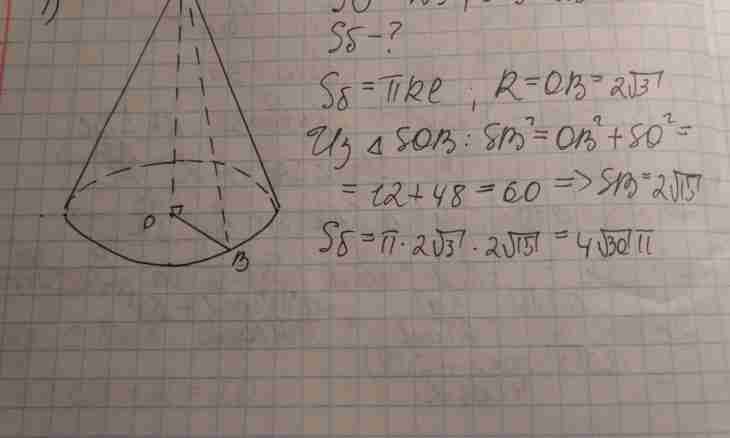The direct cone is a body which turns out at rotation of a rectangular triangle around one of legs. This leg is H cone height, other leg is the radius of its basis of R, the hypotenuse is equal to a set forming a cone of L. The way of finding of radius of a cone depends on basic data of a task.
Instruction
1. If the volume of V and height of a cone of H are known to you, express its radius of R basis from formula V=1/3 ∙πR²H. Receive: R²=3V/πH, from where R= √ (3V/πH).
2. If the area of a side surface of a cone of S and length it forming L are known to you, express R radius from a formula: S=πRL. You receive R=S/πL.
3. The following ways of finding of radius of the basis of a cone are based on a statement that the cone is formed at rotation of a rectangular triangle around one of legs to an axis. So, if height of a cone of H and length it forming L are known to you, then for finding of radius of R you can use Pythagorean theorem: L²=R²+H². Express from this formula R, receive: R²=L²–H² and R= √ (L²–H²).
4. Use rules of ratios between the parties and corners in rectangular triangle. If are known forming a cone of L and a corner α between height of a cone and forming it, find R basis radius equal to one of legs of a rectangular triangle, on a formula: R=L∙sinα.
5. If are known forming a cone of L and a corner β between the radius of the basis of a cone and forming it, find R basis radius on a formula: R=L∙cosβ. If height of a cone of H and a corner α between its forming and the radius of the basis are known, find R basis radius on a formula: R=H∙tgα.
6. Example: forming a cone of L it is equal to 20 cm and a corner α between forming and height of a cone it is equal 15º. Find cone basis radius. Decision: In a rectangular triangle with a hypotenuse of L and an acute angle α opposite to this corner the leg of R is calculated on a formula R=L∙sinα. Substitute the corresponding values, receive: R=L∙sinα=20∙sin15º. Sin15º is from formulas of trigonometrical functions of a half argument and is equal 0.5 √ (2– √ 3). From here R=20∙0.5 leg √ (2– √ 3)=10 √ (2– √ 3) see. Respectively, the radius of the basis of a cone of R is equal 10 √ (2– √ 3) see.
7. Special case: in a rectangular triangle the leg, opposite a corner in 30º, is equal to a half of a hypotenuse. Thus, if are known length forming a cone and a corner between its forming and height it is equal 30º, then find radius on a formula: R=1/2L.

